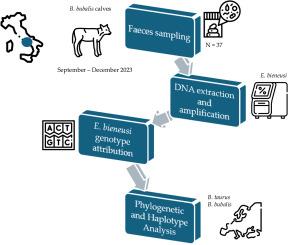Enterocytozoon bieneusi in Italian water buffalo calves (Bubalus bubalis): An exploratory haplotype analysis within Bovidae family in the European context
IF 3.1
Q2 PARASITOLOGY
引用次数: 0
Abstract
Microsporidia are an important group of emerging opportunistic parasites in human and non-human animals, with possible zoonotic potential; however, no data are currently available on their presence in commonly farmed species in Italy, particularly regarding Enterocytozoon bieneusi in water buffalo (Bubalus bubalis). This preliminary study investigated the prevalence and genetic variability of E. bieneusi in water buffalo calves in southern Italy. Additionally, given its spread among other members of the Bovidae family, a haplotype-level network analysis was performed using E. bieneusi sequences available in GenBank from two of the most commonly farmed Bovidae species in Europe: cattle (Bos taurus) and water buffalo (B. bubalis). The survey was conducted on four farms between September and December 2023 for a total of 37 buffaloes sampled. DNA extracted from collected faeces was subjected to molecular analysis amplifying ITS region. For the molecular characterization, a phylogenetic analysis was performed by Maximum Likelihood method. For the comparison between our sequences and those available from water buffaloes and cattle from Europe, a haplotype analysis was conducted to obtain a network calculation. Five samples from Italian B. bubalis tested positive for E. bieneusi with an overall prevalence value of 13.5 %. Phylogenetic analysis assigned isolates to three genotypes (YNDCEB-90; A; I) which were shared among different hosts, including humans and clustering in the phylogenetic Group 1 and Group 2. The network analysis identified Hp9 as the most frequently detected haplotype, distributed across multiple countries, including Italy. The second most common haplotype, Hp12, was exclusively found in Italy and Turkey from B. bubalis. The differences in haplotype patterns observed between B. taurus and B. bubalis could shed light on the species-specific interactions of E. bieneusi. The prevalence observed, along with the detection of zoonotic genotypes in water buffaloes, could pose a potential public health concern. The associated risk extends beyond the direct contact with infected animals or their faeces, encompassing possible contamination of the food chain and the environment, including ground and surface water sources.

意大利水牛幼崽肠细胞虫(Bubalus bubalis):欧洲牛科单倍型的探索性分析
微孢子虫是人类和非人类动物中一种重要的新出现的机会性寄生虫,可能具有人畜共患的潜力;然而,目前没有数据表明它们在意大利的普通养殖物种中存在,特别是在水牛(Bubalus bubalis)中的双氏肠细胞虫。本初步研究调查了意大利南部水牛幼崽中布氏伊布氏绦虫的流行率和遗传变异性。此外,考虑到其在牛科其他成员中的传播,利用GenBank中欧洲最常见的两种养殖牛科物种:牛(Bos taurus)和水牛(B. bubalis)的bieneusi序列进行了单倍型水平的网络分析。该调查于2023年9月至12月在四个农场进行,共采集了37头水牛样本。从收集的粪便中提取DNA进行分子分析,扩增ITS区域。采用极大似然法进行系统发育分析。为了将我们的序列与来自欧洲的水牛和牛的序列进行比较,进行了单倍型分析以获得网络计算。来自意大利的5个贝氏贝氏体样本经检测呈比氏贝氏体阳性,总患病率为13.5%。系统发育分析将分离株划分为三个基因型(YNDCEB-90;一个;I)在不同宿主(包括人类)之间共享,并聚集在系统发育类群1和类群2中。网络分析发现,Hp9是最常检测到的单倍型,分布在包括意大利在内的多个国家。第二常见的单倍型Hp12仅在意大利和土耳其发现。金牛白僵菌与白僵菌单倍型模式的差异可能为白僵菌的种特异性相互作用提供线索。观察到的流行情况以及在水牛中检测到的人畜共患病基因型可能构成潜在的公共卫生问题。相关风险超出了与受感染动物或其粪便的直接接触,还包括可能污染食物链和环境,包括地下水和地表水水源。
本文章由计算机程序翻译,如有差异,请以英文原文为准。
求助全文
约1分钟内获得全文
求助全文
来源期刊

Food and Waterborne Parasitology
Immunology and Microbiology-Parasitology
CiteScore
5.10
自引率
4.00%
发文量
38
审稿时长
13 weeks
期刊介绍:
Food and Waterborne Parasitology publishes high quality papers containing original research findings, investigative reports, and scientific proceedings on parasites which are transmitted to humans via the consumption of food or water. The relevant parasites include protozoa, nematodes, cestodes and trematodes which are transmitted by food or water and capable of infecting humans. Pertinent food includes products of animal or plant origin which are domestic or wild, and consumed by humans. Animals and plants from both terrestrial and aquatic sources are included, as well as studies related to potable and other types of water which serve to harbor, perpetuate or disseminate food and waterborne parasites. Studies dealing with prevalence, transmission, epidemiology, risk assessment and mitigation, including control measures and test methodologies for parasites in food and water are of particular interest. Evidence of the emergence of such parasites and interactions among domestic animals, wildlife and humans are of interest. The impact of parasites on the health and welfare of humans is viewed as very important and within scope of the journal. Manuscripts with scientifically generated information on associations between food and waterborne parasitic diseases and lifestyle, culture and economies are also welcome. Studies involving animal experiments must meet the International Guiding Principles for Biomedical Research Involving Animals as issued by the Council for International Organizations of Medical Sciences.
 求助内容:
求助内容: 应助结果提醒方式:
应助结果提醒方式:


